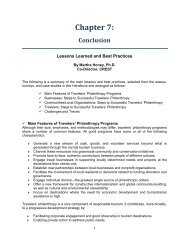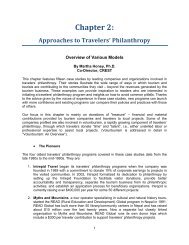Travelers' Philanthropy Handbook - Center for Responsible Travel
Travelers' Philanthropy Handbook - Center for Responsible Travel
Travelers' Philanthropy Handbook - Center for Responsible Travel
Create successful ePaper yourself
Turn your PDF publications into a flip-book with our unique Google optimized e-Paper software.
3. Create a Marketing Strategya. <strong>Travel</strong>ers’ philanthropy can and should be integrated into your company’s overallmarketing ef<strong>for</strong>t.b. Position your program(s) as a company asset.c. Pre-trip, during the trip, and post-trip communications with your customers about theprojects your company supports, and why, will increase the flow of donations.d. Promote your program and projects to the media, but avoid inflating impact.e. Use a variety of marketing tools to publicize your program, including websites,newsletters, blogs and other social networking, eco-awards, trade shows andconferences, special events, etc.4. Organize “The As k” – and Make It An “Offer”a. Develop an experiential product that leads travelers to care about the place andpeople, and then provide an opportunity <strong>for</strong> travelers to act on their caring.b. Guides and staff play an important role – they bond with travelers, can interpret localproblems and needs, and carry the good name of your company. Invest in trainingthem to introduce and promote your travelers’ philanthropy initiatives.c. Enhance learning and giving through visitor experiences. Community tours, sitevisits, and/or meetings with key community or conservation leaders can lead to morein<strong>for</strong>med and greater giving, but these interactions must be carefully planned andscheduled.d. Timing is important: don’t wait until the trip is over to solicit donations.e. Offers appealing to the travelers’ philanthropic intentions generate more donationsthan appeals focused primarily on incentives. But incentives (tax deductions,vouchers <strong>for</strong> future trips, matching funds, etc.) can play an important secondary rolein decisions to give.f. Develop several methods <strong>for</strong> ‘giving’ and collecting funds.5. Keep Donors in the Loopa. Donor engagement at the destination should be the start of a long-term relationship.Never stop communicating with your donors.b. Cultivating and maintaining a connection with the donors after they return home is astrong component of assuring sustainability of your program.c. Keeping in close touch with donors increases the likelihood of renewed funding.Develop a standardized and regularized – usually quarterly - reporting via donornewsletters and financial reports, and supplement this with social media and theweb.d. Communicate to your donors how their support impacts the project they supportedand how the project has trans<strong>for</strong>med the community and environment.e. Use all types of reporting, including a “light” version – personalized reports <strong>for</strong> donors-- and a “heavy” version on project development with financial audits <strong>for</strong> foundationsand donors who request more details.6. Follow Sound Management Principles <strong>for</strong> Handling Donated Fundsa. Determine where your program’s funding will come from: the company, staff,travelers, foundations and grants, fundraising activities.b. Funds should not be deposited or held in a company account. Donations must beaccounted <strong>for</strong> separately from the finances of your business.210















